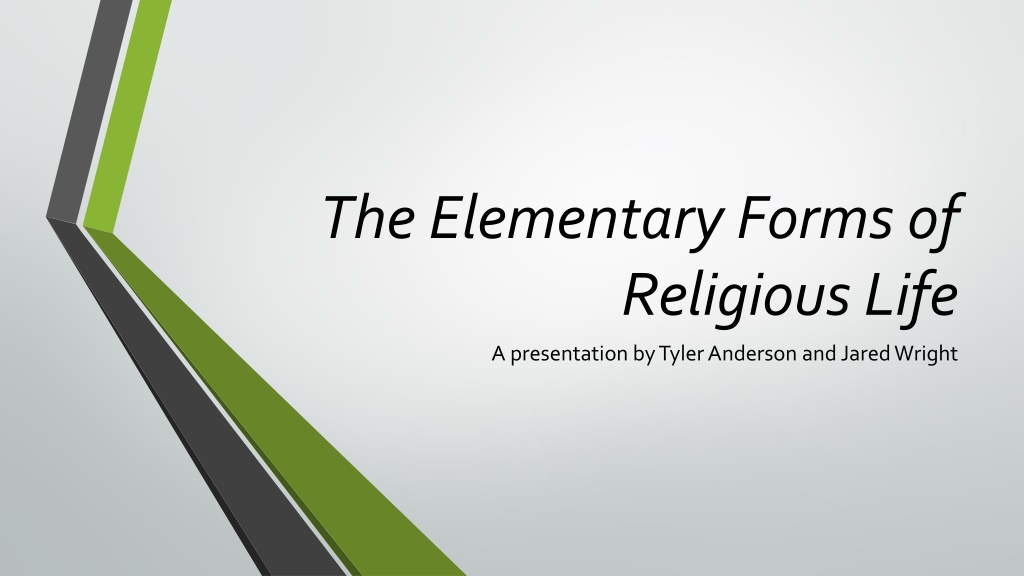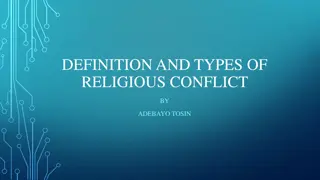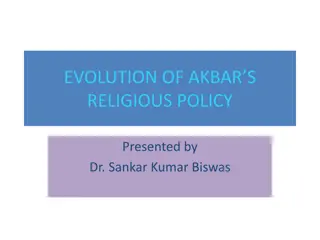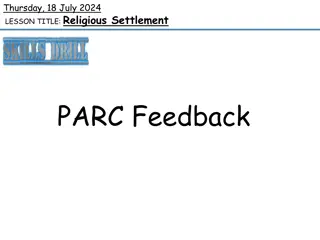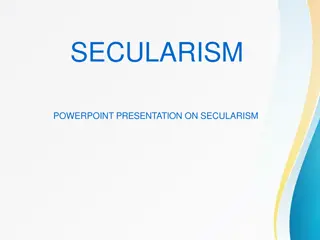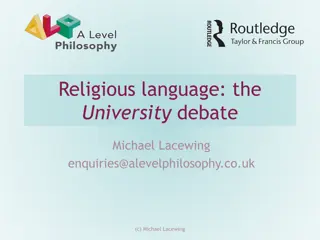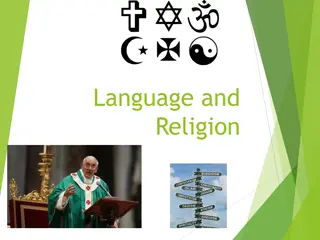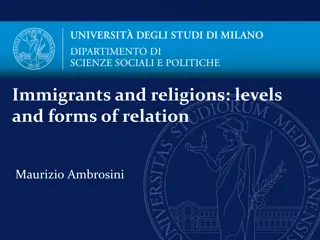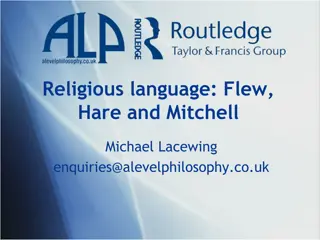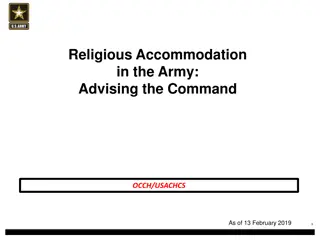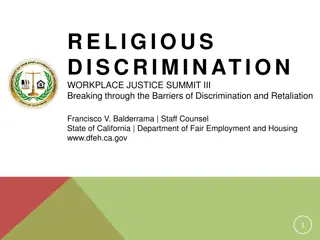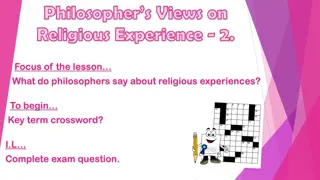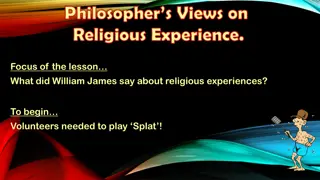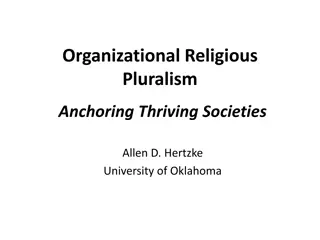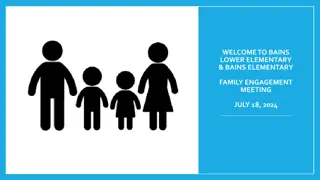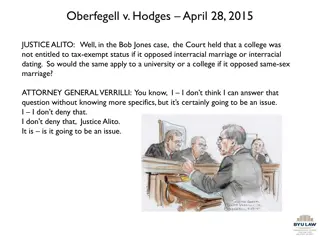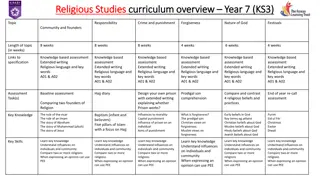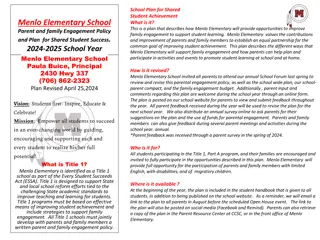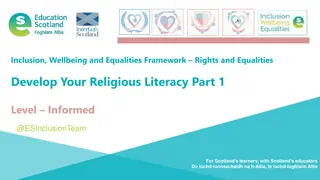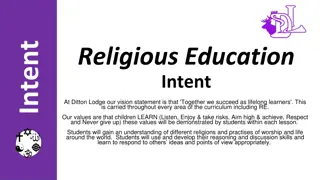The Elementary Forms of Religious Life
Presentation exploring Durkheim's objective view of religious belief, defining religion as social and discussing sacred vs. profane concepts.
Download Presentation

Please find below an Image/Link to download the presentation.
The content on the website is provided AS IS for your information and personal use only. It may not be sold, licensed, or shared on other websites without obtaining consent from the author.If you encounter any issues during the download, it is possible that the publisher has removed the file from their server.
You are allowed to download the files provided on this website for personal or commercial use, subject to the condition that they are used lawfully. All files are the property of their respective owners.
The content on the website is provided AS IS for your information and personal use only. It may not be sold, licensed, or shared on other websites without obtaining consent from the author.
E N D
Presentation Transcript
The Elementary Forms of Religious Life A presentation by Tyler Anderson and Jared Wright
Introduction Sociology as a positivist science Understanding the fundamental characteristics of religion Durkheim is trying to take an objective view of religious belief which can be applied to all religions
If we admit that the crude cults of the Australian tribes can help us understand Christianity, for example, is that not supposing that this latter religion proceeds from the same mentality as the former, that it is made up of the same superstitions and rests upon the same errors? (p. 2)
Introduction (cont.) Durkheim s reasons for using primitive religion as a unit of study To resolve an institution to its constituent elements in order to understand the components To better understand what is primary and secondary To better understand more complex religions What we want to do is find a means of discerning the ever-present causes upon which the most essential forms of religious thought and practice depend (p. 8)
Defining religion Religion as eminently social Durkheim rejects that religion has to have a concept of the supernatural Also rejects that religion requires a god or spiritual beings
Thus there are rites without gods, and even rites from which gods are derived. All religious powers do not emanate from divine personalities, and there are relations of cult which have other object than uniting man to a deity. Religion is more than the idea of gods or spirits, and consequently cannot be defined exclusively in relation to these latter. (p. 35)
Defining Religion (cont.) Two categories make up religion Belief Classify all things into the sacred and the profane Rituals determined modes of actions
Defining Religion (cont.) The Sacred and the Profane Profane: the mundane; ordinary Sacred: those things which man holds superior to himself Not only represented as divine beings but to multiple degrees
Defining Religion (cont.) The sacred and profane realms are diametrically opposed Beings can pass from one realm to the other, but this requires a veritable metamorphosis Initiation rites Monasticism Asceticism
Defining Religion (cont.) Magic vs. religion Religion is a social phenomenon whereas magic is inherently individual The Church Religions are characterized by their social quality The Church is a place where people can come together and practice religious beliefs In all of history, we do not find a single religion without a Church p, 44) According to Durkheim, there is no Church of magic
Definition of Religion A religion is a unified system of beliefs and practices relative to sacred things, that is to say, things set apart and forbidden beliefs and practices which unite into one single moral community called a Church, all those that adhere to them (p. 47)
Animism v. Naturism Two major perspectives attempting to explain how religions start Animism religion of spirits Naturism - religion bound in perception
Animism The soul has a second self that manifests in dreams but remains connected to the body Upon death, the soul turns into a spirit no longer bound to its profane form People assign animate properties to inanimate objects
Durkheims problems with Animism Does not explain why the soul is grounded to the individual Does not account for other possible explanations for dreams Does not answer why people would choose to explain dreams as opposed to other puzzles
Naturism What is natural is consistent, so things like fire that aren t permanent must be explained Language helps define these forces Nature is given human qualities
Problems with Naturism This explanation offers no sense of order Neglects the social element
Totemism and clans Clans united by strong bonds of kinship that aren t necessarily ancestral This kinship is represented by the totem A coat-of-arms for a clan Elevates the bond from the profane to the sacred
The Origins of Totemic Beliefs What gives the totem its sacred qualities? Effervescence Feelings of passion developed through social interaction Produce sacred feelings in the individual that must be explained Totems are a way to represent this feeling in the material world
The Idea of the Soul, Spirits, and Gods: 1. Every known contemporary society has an idea of the soul. 2. Evolved from the tribal Aborigine belief that the soul of a newborn was the reincarnation of dead ancestors of the clan, which are conceived of as animal or plant spirits with superhuman abilities, thus making them sacred.
The Idea of the Soul, Spirits, and Gods: 3. Aborigine belief developed into modern concepts such as immortality and personality. A. Immortality (303). B. civilizing hero - individual totemism - international deity (315).
The Principal of Ritual Attitudes: Negative Cults: 1. The sacred and profane realms of life cannot coexist in the same time or place. 2. Negative cult: taboos & degree of sacredness (338-340).
The Principal of Ritual Attitudes: Negative Cults: 3. Negative rites purify the individual, allowing him access to the sacred positive cult (355-356). 4. contagiousness of the sacred (356-361).
The Principal of Ritual Attitudes: Positive Cults: 1. Intichiuma(368-377). 2. Sacrificial rites of Intichiuma(380-385). 3. Mutual Interdependence (385-392).
The Principal of Ritual Attitudes: Positive Cults: 3 Other Types of Positive Rites: 1. Imitative ( like produces like ) A. scientific law of causality (412). B. moral and religious ritual as opposed to sympathetic magic. 2. Representative A. Mythology is a moral and cosmological system, not a magical one (420). B. Origin of aesthetics in modern religions (424-428). 3. Piacular
Conclusion: 1. Religion is more about action than thought. 2. Religious beliefs are based on real experiences just like scientific experiments.
Conclusion: 3. The group is more significant than the religion. 4. Scientific thought is a product of, and more perfect version of, religious thought.
Conclusion: 5. Concepts the origin of all logical/scientific thought. 6. Concepts represent nature. Concepts are made possible by society but also can express social phenomenon because society is a part of nature.
Conclusion: 7. Individual experience is subjective, but through society we create universal concepts which bring us closer to the truth. 8. We are both individual and social; we cannot exist without society any more than society can exist without us.
